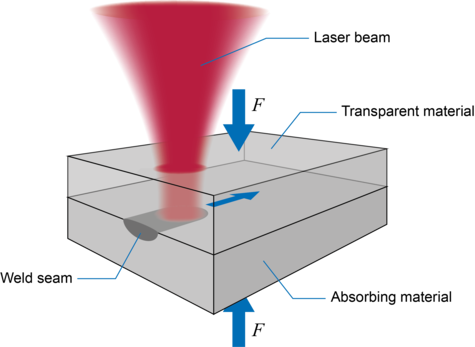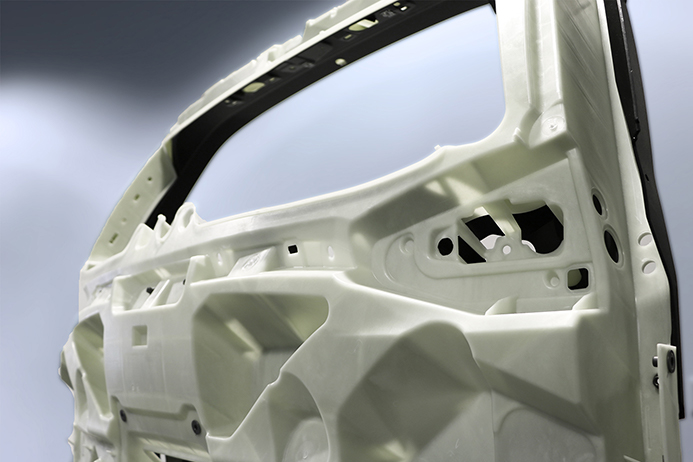Plastic Welding
Diode lasers with low and medium laser power are excellent for a high quality and durable connection of thermoplastic polymers using the transmission welding method. Different special optics and additional components such as pyrometers for temperature controlled contour welding or CMOS cameras can be adapted for a process visualization. For quasi-simultaneous welding, scan systems guide the laser focus with highly dynamic deflection mirrors on every desired 2D contour.
Plastic welding systems – the method
 With laser beam-transmission welding, a laser transparent component and laser absorbing component are always merged. Prior to being welded, the join partners are positioned and then pressed together. In the actual fusion process, the laser beam gets through the transparent component without significantly heating it up. But now, the absorbing component takes the laser energy so that it is heated at the surface. This energy is transferred via heat conduction onto the surface of the transparent component at transparent laser plastic welding. The absorbed energy plasticizes the plastic which, with pressure and heat conduction, leads to a joining of the components. The existing joining pressure results in a substance-to-substance bond for both parts. The firmness of the resulting welding is within the typical area of base material strength.
Polymer Welding: Advantages of diode lasers
Compared to conventional solid-state lasers, the diode laser has the advantage because of its wavelength spectrum and the "Top-Hat" steel profile without intensity peak. In this way, local temperature peaks are avoided which could damage the joined partners. Because of the diode laser’s local energy input, the plastic is heated very quickly and gently to the material in the joint zone, resulting in a homogeneous melt without forming fluff due to the dry friction. Setting path - or temperature-monitoring systems - can record the plastic welding process and transfer the result to a higher-level control system. Functional changes at the component or new design ideas for the welding contour can be programmed flexibly. The laser protects particularly the inside-lying and vibration-sensitive components or complex electrodes from damage by means of the contact-free heat input. The even energy distribution in the laser focus melts the welded joint without overheating the material, thus preventing pore formation. Laser is outstanding because the freedom of design is clearly extended at the development of new components and housings. Plastic laser welding services make it possible to join plastic housings with inner electronic components - which are often damaged or dirtied by conventional methods such as vibration welding or ultrasonic welding - at low thermal, mechanical impact and contact-free.
Application examples
Transmission welding of automobile tailgates
With laser beam-transmission welding, a laser transparent component and laser absorbing component are always merged. Prior to being welded, the join partners are positioned and then pressed together. In the actual fusion process, the laser beam gets through the transparent component without significantly heating it up. But now, the absorbing component takes the laser energy so that it is heated at the surface. This energy is transferred via heat conduction onto the surface of the transparent component at transparent laser plastic welding. The absorbed energy plasticizes the plastic which, with pressure and heat conduction, leads to a joining of the components. The existing joining pressure results in a substance-to-substance bond for both parts. The firmness of the resulting welding is within the typical area of base material strength.
Polymer Welding: Advantages of diode lasers
Compared to conventional solid-state lasers, the diode laser has the advantage because of its wavelength spectrum and the "Top-Hat" steel profile without intensity peak. In this way, local temperature peaks are avoided which could damage the joined partners. Because of the diode laser’s local energy input, the plastic is heated very quickly and gently to the material in the joint zone, resulting in a homogeneous melt without forming fluff due to the dry friction. Setting path - or temperature-monitoring systems - can record the plastic welding process and transfer the result to a higher-level control system. Functional changes at the component or new design ideas for the welding contour can be programmed flexibly. The laser protects particularly the inside-lying and vibration-sensitive components or complex electrodes from damage by means of the contact-free heat input. The even energy distribution in the laser focus melts the welded joint without overheating the material, thus preventing pore formation. Laser is outstanding because the freedom of design is clearly extended at the development of new components and housings. Plastic laser welding services make it possible to join plastic housings with inner electronic components - which are often damaged or dirtied by conventional methods such as vibration welding or ultrasonic welding - at low thermal, mechanical impact and contact-free.
Application examples
Transmission welding of automobile tailgates
 Lightweight construction automobile tailgates made from plastic are produced via transmission welding using Laserline’s diode lasers with a special feature: the weld seams at laser plastic welding are not visible and post-processings in the inner field of vision become completely obsolete.
Lightweight construction automobile tailgates made from plastic are produced via transmission welding using Laserline’s diode lasers with a special feature: the weld seams at laser plastic welding are not visible and post-processings in the inner field of vision become completely obsolete.
 With laser beam-transmission welding, a laser transparent component and laser absorbing component are always merged. Prior to being welded, the join partners are positioned and then pressed together. In the actual fusion process, the laser beam gets through the transparent component without significantly heating it up. But now, the absorbing component takes the laser energy so that it is heated at the surface. This energy is transferred via heat conduction onto the surface of the transparent component at transparent laser plastic welding. The absorbed energy plasticizes the plastic which, with pressure and heat conduction, leads to a joining of the components. The existing joining pressure results in a substance-to-substance bond for both parts. The firmness of the resulting welding is within the typical area of base material strength.
Polymer Welding: Advantages of diode lasers
Compared to conventional solid-state lasers, the diode laser has the advantage because of its wavelength spectrum and the "Top-Hat" steel profile without intensity peak. In this way, local temperature peaks are avoided which could damage the joined partners. Because of the diode laser’s local energy input, the plastic is heated very quickly and gently to the material in the joint zone, resulting in a homogeneous melt without forming fluff due to the dry friction. Setting path - or temperature-monitoring systems - can record the plastic welding process and transfer the result to a higher-level control system. Functional changes at the component or new design ideas for the welding contour can be programmed flexibly. The laser protects particularly the inside-lying and vibration-sensitive components or complex electrodes from damage by means of the contact-free heat input. The even energy distribution in the laser focus melts the welded joint without overheating the material, thus preventing pore formation. Laser is outstanding because the freedom of design is clearly extended at the development of new components and housings. Plastic laser welding services make it possible to join plastic housings with inner electronic components - which are often damaged or dirtied by conventional methods such as vibration welding or ultrasonic welding - at low thermal, mechanical impact and contact-free.
Application examples
Transmission welding of automobile tailgates
With laser beam-transmission welding, a laser transparent component and laser absorbing component are always merged. Prior to being welded, the join partners are positioned and then pressed together. In the actual fusion process, the laser beam gets through the transparent component without significantly heating it up. But now, the absorbing component takes the laser energy so that it is heated at the surface. This energy is transferred via heat conduction onto the surface of the transparent component at transparent laser plastic welding. The absorbed energy plasticizes the plastic which, with pressure and heat conduction, leads to a joining of the components. The existing joining pressure results in a substance-to-substance bond for both parts. The firmness of the resulting welding is within the typical area of base material strength.
Polymer Welding: Advantages of diode lasers
Compared to conventional solid-state lasers, the diode laser has the advantage because of its wavelength spectrum and the "Top-Hat" steel profile without intensity peak. In this way, local temperature peaks are avoided which could damage the joined partners. Because of the diode laser’s local energy input, the plastic is heated very quickly and gently to the material in the joint zone, resulting in a homogeneous melt without forming fluff due to the dry friction. Setting path - or temperature-monitoring systems - can record the plastic welding process and transfer the result to a higher-level control system. Functional changes at the component or new design ideas for the welding contour can be programmed flexibly. The laser protects particularly the inside-lying and vibration-sensitive components or complex electrodes from damage by means of the contact-free heat input. The even energy distribution in the laser focus melts the welded joint without overheating the material, thus preventing pore formation. Laser is outstanding because the freedom of design is clearly extended at the development of new components and housings. Plastic laser welding services make it possible to join plastic housings with inner electronic components - which are often damaged or dirtied by conventional methods such as vibration welding or ultrasonic welding - at low thermal, mechanical impact and contact-free.
Application examples
Transmission welding of automobile tailgates
 Lightweight construction automobile tailgates made from plastic are produced via transmission welding using Laserline’s diode lasers with a special feature: the weld seams at laser plastic welding are not visible and post-processings in the inner field of vision become completely obsolete.
Lightweight construction automobile tailgates made from plastic are produced via transmission welding using Laserline’s diode lasers with a special feature: the weld seams at laser plastic welding are not visible and post-processings in the inner field of vision become completely obsolete.
